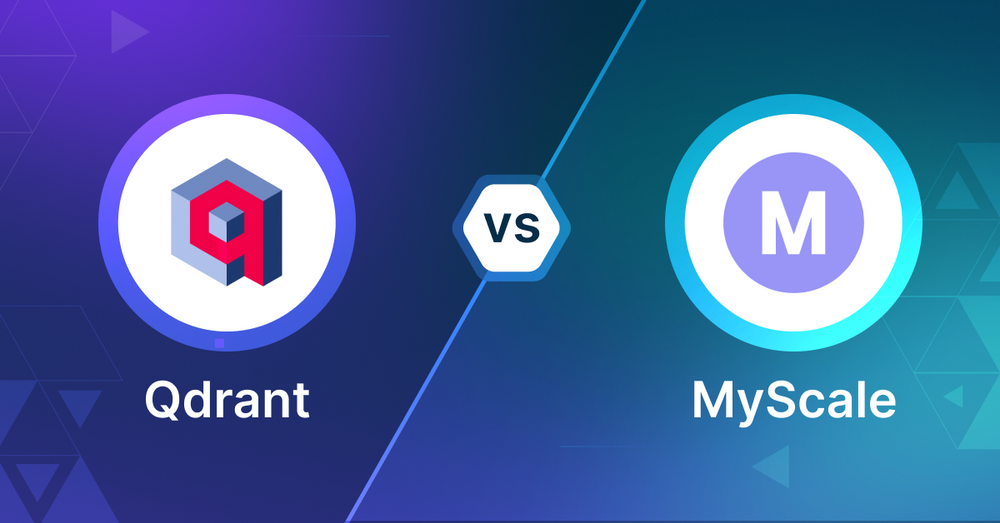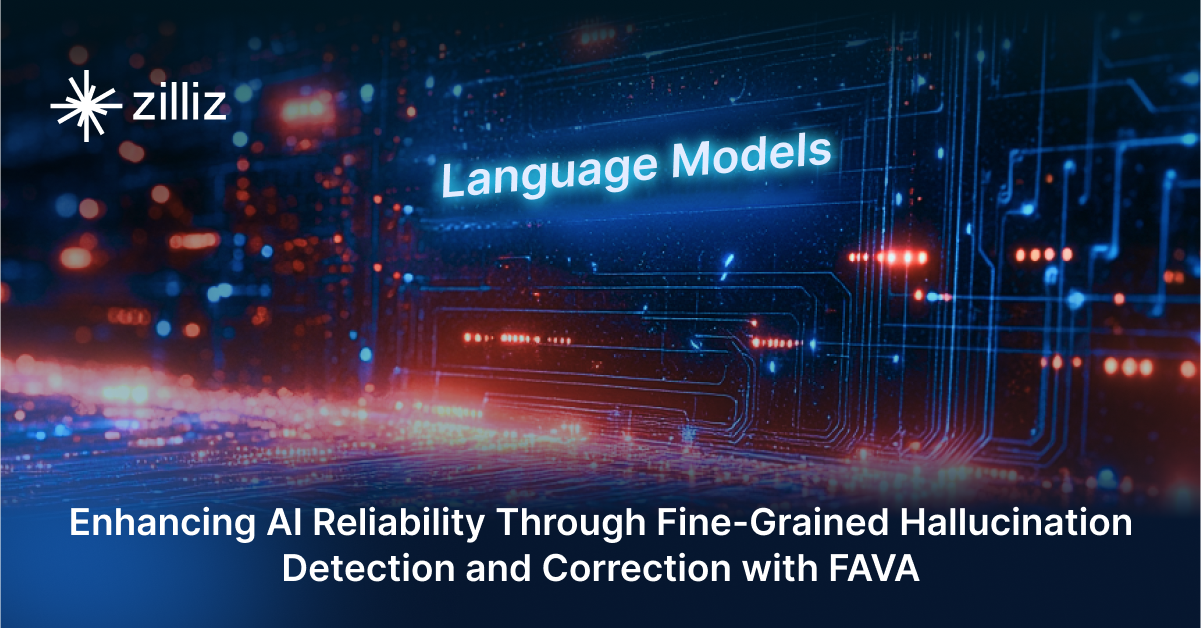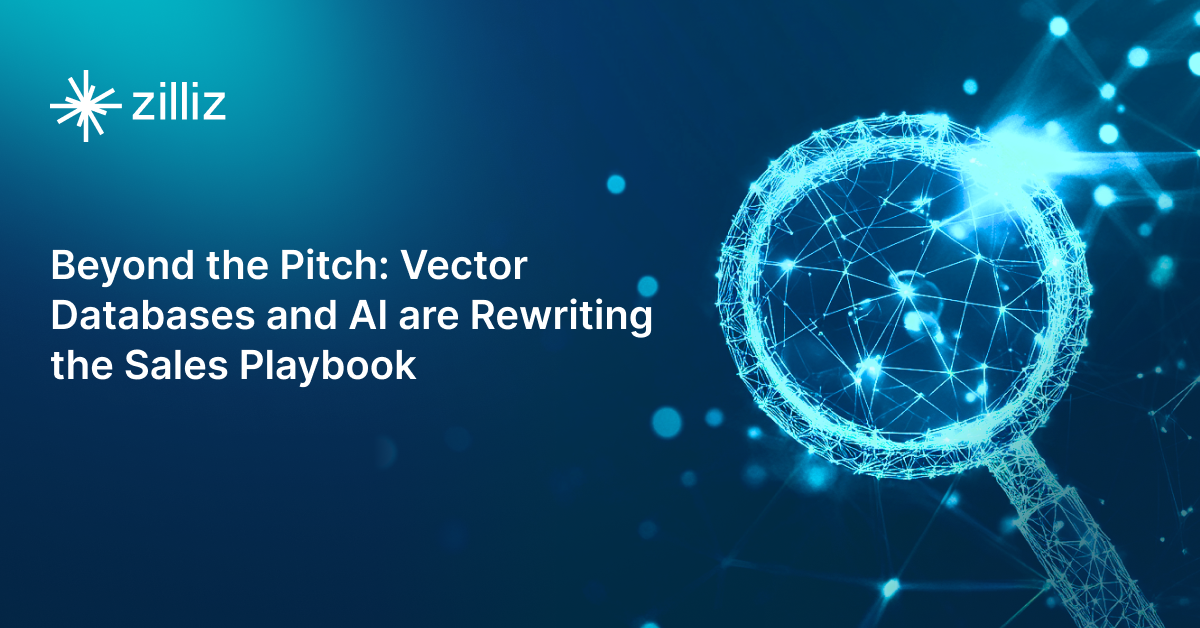Qdrant vs Myscale Choosing the Right Vector Database for Your AI Apps

What is a Vector Database?
Before we compare Qdrant and MyScale, let's first explore the concept of vector databases.
A vector database is specifically designed to store and query high-dimensional vectors, which are numerical representations of unstructured data. These vectors encode complex information, such as the semantic meaning of text, the visual features of images, or product attributes. By enabling efficient similarity searches, vector databases play a pivotal role in AI applications, allowing for more advanced data analysis and retrieval.
Common use cases for vector databases include e-commerce product recommendations, content discovery platforms, anomaly detection in cybersecurity, medical image analysis, and natural language processing (NLP) tasks. They also play a crucial role in Retrieval Augmented Generation (RAG), a technique that enhances the performance of large language models (LLMs) by providing external knowledge to reduce issues like AI hallucinations.
There are many types of vector databases available in the market, including:
- Purpose-built vector databases such as Milvus, Zilliz Cloud (fully managed Milvus)
- Vector search libraries such as Faiss and Annoy.
- Lightweight vector databases such as Chroma and Milvus Lite.
- Traditional databases with vector search add-ons capable of performing small-scale vector searches.
Qdrant is a purpose-built vector database. MyScale is a database built on ClickHouse that combines vector search and SQL analytics with vector search capabilities as an add-on. This post compares their vector search capabilities.
Qdrant: Overview and Core Technology
Qdrant is a vector database for similarity search and machine learning. Built from the ground up for vector data, it’s the go to choice for AI developers. Qdrant optimizes performance and can handle high dimensional vector data which is key for many modern ML models.
One of the key strengths of Qdrant is its flexible data modeling. You can store and index not just vectors but also payload data associated with each vector. This means you can run complex queries that combine vector similarity with filtering on metadata, so you can have more powerful and nuanced search. Qdrant ensures data consistency with ACID compliant transactions even during concurrent operations.
Qdrant’s vector search is at the heart of the platform. It uses a custom version of the HNSW (Hierarchical Navigable Small World) algorithm for indexing which is efficient in high dimensional spaces. The Distance Matrix API allows to calculate efficiently pairwise distances between vectors, so it’s great for tasks like clustering and dimensionality reduction - even with thousands of vectors. For scenarios where precision matters more than speed, Qdrant also supports exact search and provides visual tools to explore vector relationships through the Graph UI.
What’s special about Qdrant is its query and optimization features. Its query language works seamlessly with vector search and supports complex operations including a powerful Facet API to aggregate and count unique values in the data. Memory optimization features like on-disk text and geo indexing allow to handle large scale deployments while keeping performance through intelligent caching. Qdrant has automatic sharding and replication for scalability and supports various data types and query conditions from string matching to numerical ranges and geo-locations. The scalar, product and binary quantization features can reduce memory usage and speed up search, especially for high dimensional vectors.
You can configure the trade off between search precision and performance with both approximate and exact matching depending on your use case. The architecture is designed for real world scenarios where vector search needs to be combined with filtering and aggregation, so it’s great for building practical AI applications.
What is MyScale? Overview and Core Technology
MyScale is a cloud based database built on top of the open source ClickHouse database, designed for AI and machine learning workloads. It can handle structured and vector data and real time analytics and machine learning. MyScale is focused on time series, vector search and full text search so it’s good for real time processing and AI driven insights. By using ClickHouse architecture, MyScale is high performance and scalable for AI.
One of the key features of MyScale is native SQL support which simplifies AI driven queries by integrating vector search, full text search and traditional SQL queries in one system. This reduces the need for multiple tools and makes it scalable for AI. MyScale supports and manages analytical processing of both structured and vectorized data on one platform using OLAP database architecture to operate on vectorized data. Developers can interact with MyScale using SQL so it’s accessible to all programmers familiar with relational databases.
MyScale has multiple vector index types and similarity metrics to support different use cases. It supports common distance metrics like Euclidean distance (L2), inner product (IP) and cosine similarity. The database has multiple indexing algorithms: MSTG (Multi-Scale Tree Graph), ScaNN, IVFFLAT, IVFPQ, IVFSQ and HNSW, each with its own set of parameters to tune. MyScale’s proprietary MSTG vector engine uses NVMe SSDs to increase data density so it outperforms specialized vector databases in both performance and cost.
By combining the functionality of an SQL database, vector database and full text search engine into one system MyScale reduces infrastructure and maintenance costs. This unification allows for joint data queries and analytics and a single data foundation for AI applications. MyScale also has MyScale Telemetry for full observability of LLM systems so you can monitor and debug efficiently. As data gets more complex MyScale is a future proof solution that can handle newer data modalities and database sizes while keeping computing performance and integration between different data types.
Key Differences
Search Methodology
Qdrant uses a highly optimized version of the HNSW (Hierarchical Navigable Small World) algorithm for approximate nearest neighbor (ANN) searches. This algorithm excels in high-dimensional spaces, making it ideal for AI applications like recommendation systems and semantic search. Qdrant also supports exact search when precision is a priority and offers tools like the Distance Matrix API for tasks like clustering and dimensionality reduction.
MyScale, built on ClickHouse, provides multiple indexing algorithms such as MSTG (Multi-Scale Tree Graph), ScaNN, and HNSW. Each algorithm is tunable, offering flexibility for diverse use cases. MSTG stands out with its NVMe SSD optimization, enabling high data density and cost-effective performance for large-scale vector search.
Data Handling
Qdrant is purpose-built for vector data and offers the ability to store both vectors and associated payload data. This flexibility enables complex queries that combine vector similarity with metadata filtering, useful for applications like personalized recommendations. Qdrant also supports diverse query conditions, from string matching to numerical ranges and geo-locations.
MyScale, on the other hand, integrates structured and vector data seamlessly in a single platform. It’s designed for use cases that require real-time analytics alongside vector search, such as time-series data or full-text search. Its OLAP-based architecture is well-suited for analytical workloads, enabling simultaneous processing of relational and vectorized data.
Scalability and Performance
Qdrant achieves scalability through automatic sharding and replication. Its memory optimization features, including on-disk indexing, allow it to handle large-scale deployments efficiently. It also offers tools to balance precision and performance, making it suitable for applications requiring both approximate and exact matching.
MyScale leverages ClickHouse’s distributed architecture for high scalability and throughput. It supports massive datasets using NVMe SSDs for efficient storage and retrieval, making it a robust choice for real-time, high-performance AI applications.
Flexibility and Customization
Qdrant provides significant flexibility with its query language, which integrates vector search with filtering and aggregation. Features like the Facet API enable advanced data exploration, and its customizable indexing options let developers optimize for specific use cases.
MyScale emphasizes versatility by combining traditional SQL capabilities with advanced vector search. This unified approach simplifies workflows, allowing developers to perform joint queries across structured and vector data without switching tools.
Integration and Ecosystem
Qdrant integrates well with machine learning pipelines and popular frameworks, offering APIs in multiple programming languages. It is highly compatible with modern AI workflows, making it a natural choice for developers focused on ML and AI projects.
MyScale benefits from its SQL-based interface, making it accessible to developers familiar with relational databases. Its support for time-series, full-text search, and vector search positions it as a multi-purpose tool that can reduce infrastructure complexity.
Ease of Use
Qdrant offers comprehensive documentation and visual tools like the Graph UI, which simplifies the exploration of vector relationships. Its setup process is straightforward, and the platform’s intuitive query design reduces the learning curve.
MyScale builds on ClickHouse’s SQL foundation, making it user-friendly for those with database experience. The ability to write queries in standard SQL minimizes the learning curve for developers transitioning from traditional databases.
Cost Considerations
Qdrant is resource-efficient due to its memory optimization features, but operational costs will depend on your deployment and the scale of your workload. While open-source, managed services or hosting can introduce additional expenses.
MyScale reduces costs by consolidating multiple functionalities—SQL database, vector search, and full-text search—into a single platform. This unification can lower infrastructure and maintenance expenses, especially for organizations already using ClickHouse.
Security Features
Both systems prioritize security but differ in their approaches.
Qdrant ensures ACID compliance for consistent and secure data handling, even during concurrent operations.
MyScale incorporates ClickHouse’s robust security features, including encryption, role-based access control, and detailed audit logs.
When to use Qdrant
Qdrant is for applications around vector similarity search and machine learning workflows. Combining vector search with metadata filtering makes it great for personalization, semantic search and AI driven insights. With HNSW indexing, ACID compliance and memory optimizations Qdrant is perfect for large scale high dimensional vector data. It’s for companies building AI pipelines where vector data is the main focus and search nuances are important.
When to use MyScale
MyScale is for hybrid use cases where vector search needs to be combined with structured data, real-time analytics and full-text search. Its SQL based interface is for developers familiar with relational databases, while its OLAP based architecture is for complex analytical workloads. By having multiple functionality in one system MyScale is a great option for companies looking for a scalable and cost effective platform to manage multiple data types and get insights from AI and real-time analytics.
Summary
Qdrant and MyScale are different. Qdrant is a purpose built vector database for high dimensional data and advanced AI use cases, MyScale is a unified platform for vector search and structured data and real-time analytics. Choose what fits your use case – advanced vector search or a tool that can handle multiple data modalities.
Read this to get an overview of Qdrant and MyScale but to evaluate these you need to evaluate based on your use case. One tool that can help with that is VectorDBBench, an open-source benchmarking tool for vector database comparison. In the end, thorough benchmarking with your own datasets and query patterns will be key to making a decision between these two powerful but different approaches to vector search in distributed database systems.
Using Open-source VectorDBBench to Evaluate and Compare Vector Databases on Your Own
VectorDBBench is an open-source benchmarking tool for users who need high-performance data storage and retrieval systems, especially vector databases. This tool allows users to test and compare different vector database systems like Milvus and Zilliz Cloud (the managed Milvus) using their own datasets and find the one that fits their use cases. With VectorDBBench, users can make decisions based on actual vector database performance rather than marketing claims or hearsay.
VectorDBBench is written in Python and licensed under the MIT open-source license, meaning anyone can freely use, modify, and distribute it. The tool is actively maintained by a community of developers committed to improving its features and performance.
Download VectorDBBench from its GitHub repository to reproduce our benchmark results or obtain performance results on your own datasets.
Take a quick look at the performance of mainstream vector databases on the VectorDBBench Leaderboard.
Read the following blogs to learn more about vector database evaluation.
Further Resources about VectorDB, GenAI, and ML
- What is a Vector Database?
- Qdrant: Overview and Core Technology
- What is MyScale? Overview and Core Technology
- Key Differences
- When to use Qdrant
- When to use MyScale
- Summary
- Using Open-source VectorDBBench to Evaluate and Compare Vector Databases on Your Own
- Further Resources about VectorDB, GenAI, and ML
Content
Start Free, Scale Easily
Try the fully-managed vector database built for your GenAI applications.
Try Zilliz Cloud for FreeKeep Reading

Zilliz Cloud Launches in AWS Australia, Expanding Global Reach to Australia and Neighboring Markets
We're thrilled to announce that Zilliz Cloud is now available in the AWS Sydney, Australia region (ap-southeast-2).

Enhancing AI Reliability Through Fine-Grained Hallucination Detection and Correction with FAVA
In this blog, we will explore the nature of hallucinations, the taxonomy that provides a framework for categorizing them, the FAVABENCH dataset designed for evaluation, and how FAVA detects and corrects errors.

Beyond the Pitch: Vector Databases and AI are Rewriting the Sales Playbook
Discover how AI and vector databases are transforming sales platforms with intelligent lead matching, automated workflows, and real-time insights. Learn why 43% of sales teams use AI in 2024.
The Definitive Guide to Choosing a Vector Database
Overwhelmed by all the options? Learn key features to look for & how to evaluate with your own data. Choose with confidence.